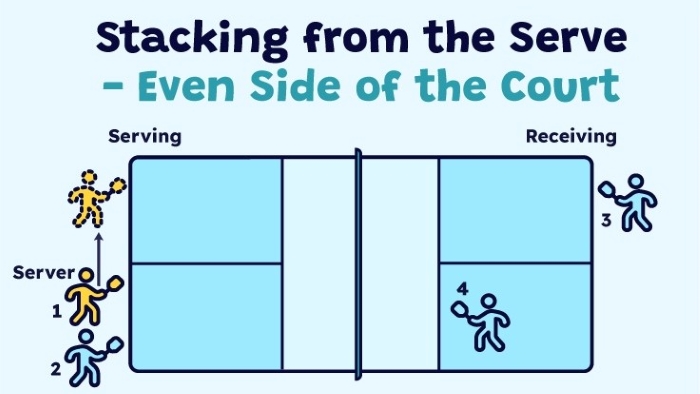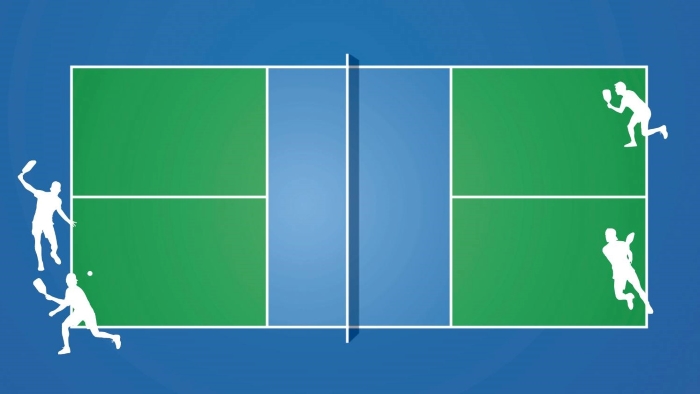Pickleball is a sport that has been gaining popularity in recent years, and as with any sport, there are strategies and techniques that players can use to improve their performance. One such technique is stacking, a procedure that is typically used in pickleball to gain a strategic advantage over opponents.
Stacking applies to positioning players in a specific way on the court to expand their range. Make it more challenging for their opponents to hit the ball in places that are easier to defend. This technique can be used for both defensive and offensive intents and can be a strong tool in a player’s arsenal if used perfectly.
In this article, we will take a closer look at what stacking is, how it works, and the pros and cons of using this approach in pickleball.
How to Stack in Pickleball
When playing pickleball, stacking refers to the act of positioning yourself in front of your opponent in order to make it more difficult for them to return the ball.

This can be done by either standing in front of them or by positioning yourself closer to the net. Stacking can be an effective way to win points, but it can also be considered unsportsmanlike if done excessively.
The Basics of Stacking
When it comes to pickleball, many think of two players volleying a ball over a net. What some may not know is that four people can also partake in the game through ‘stacking’.
With teams of two, one team serves the ball to their opponent’s backcourt, who then sends it anywhere they choose. As with doubles, the goal is to score points by hitting the ball into their opponent’s court and being unable to return it. The first side to reach 11 points wins.
Note: It should be a legal pickleball serve.
For beginners, playing in doubles would likely be advised until you grow accustomed to playing. However, stacking can still be great fun!
How to Stack in Pickleball
Pickleball is a sport that requires a combination of skills, strategy, and athleticism to win points. One of the most famous strategies used by players is stacking. It concerns positioning oneself on the court in a way that makes it more challenging for rivals to hit winning shots.
There are two common ways to stack in pickleball.
- The first way is to position oneself on the same side of the court as their partner. This allows both players to protect more ground, which makes it harder for their competitors to it the ball into open areas of the court.
- The second way is to position oneself behind the serving partner, which delivers a better view of the court and enables the player to cover more ground.
To use the stacking technique effectively, it is essential for all players on a team to use it consistently. If even one player fails to use it, the strategy can become useless, and opponents can easily score points.
Successful implementation of the stacking strategy needs effective communication and coordination between teammates. Players must be able to predict their opponents’ shots and adjust their position quickly to protect against them.
When to Stack in Pickleball
Stacking occurs when one player hits the ball twice in a row without giving their opponents a chance to hit the ball. It is considered a strategic move because it allows the player to control the rally. Also keep their opponents on the defensive.
There are two main situations where stacking can be used effectively:
1. When your opponent is weaker at returning balls that are hit deep into their court.
2. When your opponent is hitting short balls and you want to take advantage of their positioning.

If you find yourself in either of these situations, consider using a stack to give yourself an edge in the rally!
The Pros and Cons of Stacking
Pickleball is a fast-paced, competitive game that requires players to have a variety of skills and strategies. Stacking is a technique that has become increasingly popular in recent years. Like any strategy, it has both pros and cons.
Pros:
- Allows the player to keep the ball in play for longer rallies. Stacking can be an effective way to keep the ball in play during long rallies.
- The technique involves hitting the ball with a high amount of topspin, which causes the ball to bounce high and come back down close to the player who hit it. This can help to prolong rallies and give players more opportunities to score points.
- Makes it difficult for opponents to return tough shots: Because of the high amount of topspin used in stacking, it can be hard for rivals to return tough shots. This is especially true when stacking is used on dinks, as the ball will come back down close to the net, making it harder for opponents to hit a good shot.
- Can be used to set up scoring opportunities: Stacking can also be used to set up scoring chances. By hitting the ball in a way that makes it difficult for competitors to return, players can create openings for themselves to hit winners and score points.
- Offers strategic advantages on the court allowing players more control of the flow of the game: Stacking can be used strategically to control the flow of the game. By shooting the ball in a way that makes it difficult for opponents to return. Players can dictate the pace of the game and force opponents to play on their terms.
Cons:
- Takes a lot of preparation and skill to master: Stacking is not an easy technique to master. It requires a lot of training and skill to be able to hit the ball with the right amount of topspin and control.
- If not done perfectly, can result in unforced errors: If stacking is not executed correctly, it can result in voluntary errors. This can be frustrating for players and can lead to lost points.
- Can be very tiring for the player if used too much: Stacking can be a tiring technique to use, especially if it is used too much. The high amount of topspin used in stacking demands a lot of energy, and participants may tire fast if they rely too heavily on this strategy.
- Not as aggressive as other strokes and uses more energy: Stacking is not as bold as other strokes, such as drives, and it uses more energy. This means that players who rely heavily on stacking may not be as effective in aggressive play or in long matches.
- Opponents may start targeting your fault: If candidates notice that a player is using stacking as their primary approach, they may start targeting their weakness. This can make it more difficult for the player to execute their strategy and may lead to lost points.
Half Stacking vs Full Stacking – Pros and Cons
There are two main types of stacking in pickleball: half-stacking and full stacking. Half stacking is when one player stacks on the back line while the other player covers the front court. Full stack is when both players stack on the back line. Each has its own benefits and drawbacks.

Half Stacking
Pros:
-Allows for more coverage of the court since there are two players on the back line.
-Can be more effective at creating angles and shots since there are two players to work with.
-Each player can take turns being the aggressor or defender, depending on what the situation calls for.
-Gives each player a chance to rest while their partner is playing up front.
Cons:
-Requires communication and coordination between partners in order to be effective.
-Can be more difficult to defend against a strong offensive team since there are only two defenders back.
-If one player is not playing well, it can put extra pressure on their partner to perform.
Full Stacking
Pros:
-Both players are able to focus on offense since they don’t have to worry about defense as much.
-Can be very effective at catching opponents off guard since they’re not expecting both players to be upfront.
-Eliminates the need for communication since both players are already in position.
Cons:
-Leaves the entire backcourt uncovered, which can be exploited by opponents. If they are able to hit shots over the stack.
-Can be more tiring since both players are constantly running and moving up front.
-Requires a lot of trust between partners, since one mistake can lead to an easy point for the opponent.
For More Information: Go to Pickleball Storage.
How to Stack on The Return of Serve
When your opponents are serving, you can move up to the non-volley zone line and wait for their return. This is called “stacking.”
Stacking gives you a number of advantages.
- First, it allows you to take a more aggressive return of serve since you’re closer to the net.
- Second, it puts pressure on your opponents by forcing them to make a difficult shot over your outstretched paddle.
- And third, it gives you a split-second head start on any potential volleys that may result from the return of serve.
To stack effectively, start by positioning yourself near the middle of the court on your opponent’s side of the net. As they serve, quickly move up to the non-volley line and get ready to pounce on their return.
Don’t be afraid to be aggressive with your return. Remember, they’re trying to keep the ball away from you! If they manage to get the ball past you, be prepared to sprint forward and take any subsequent volleys at the net.
With a little practice, stacking will become second nature and you’ll be well on your way to dominating your pickleball games!
Pickleball Stacking Rules
When playing Pickleball, there are certain pickleball rules that must be followed in order to stack the balls correctly. Here are the rules:
- All of the balls must be touching each other in order for them to be considered stacked.
- The balls must be arranged in a pyramid shape, with the largest ball at the bottom and the smallest ball at the top.
- Once the balls are stacked, they cannot be moved until the game is over.
- If any of the balls fall over during the game, they must be picked up and placed back in their original position.
FAQs
Stacking is a strategy used in doubles pickleball where the partners switch their positions on the court. Typically, one partner will play on the right side of the court and the other on the left, but stacking involves switching this arrangement so that one player plays on the same side as their partner.
Stacking is often used to take advantage of a player’s strengths or to disrupt the opponents’ game plan. For example, if one player has a stronger forehand than backhand, stacking may allow them to better utilize that strength. Stacking can also be used to confuse opponents who are used to playing against a particular formation
The decision to use the stacking strategy should be based on the strengths and weaknesses of both teams, as well as the score and other game factors. Stacking can be especially effective when used as a surprise tactic or to break up the rhythm of the opponents.
The players must communicate and agree on when to switch positions, which is usually done during a side out or at the beginning of a new game. The player who is moving to the opposite side of the court should cross behind their partner to avoid interfering with the opponent’s shot.
Stacking can be risky if the players are not comfortable with the new positions or if the opponents are able to exploit any weaknesses created by the switch. Additionally, if the players are not communicating effectively, confusion and errors can result.
Conclusion
In conclusion, stacking in pickleball is an advanced technique used to improve the odds of winning a point. It requires exact timing and excellent contact between teammates in order to be successful.
With exercise and commitment, players can master this process and become more effective candidates. Stacking is not only a powerful tool for professional players. It also offers recreational players the opportunity to level up their game by discovering new skills and strategies.



